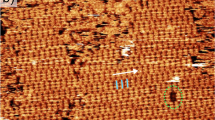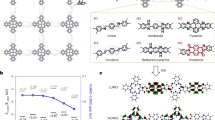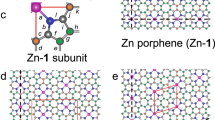Abstract
PORPHYRIN derivatives play a central part in energy- and electron-transfer processes in natural systems, in which they occur as individual entities or, commonly, as oligomers or supramolecular assemblies. These compounds have also been proposed for use in conducting and photoconducting bulk materials and as conductive and capacitive elements in molecular electronic devices. Much effort has therefore been devoted towards understanding the factors that control energy and charge transport within porphyrin assemblies. Here we describe studies of charge migration along one-dimensional columnar stacks of porphyrin molecules bearing peripheral hydrocarbon groups. In both the solid phase and the relatively plastic liquid-crystalline mesophase, in which the hydrocarbon groups are mobile, charge is transferred between adjacent porphyrin groups with a jump time of a few picoseconds or less. The isotropic liquid phase, on the other hand, is not conductive. The formation of supramolecular structures therefore seems to be necessary to support and direct charge and energy migration in these systems.
This is a preview of subscription content, access via your institution
Access options
Subscribe to this journal
Receive 51 print issues and online access
$199.00 per year
only $3.90 per issue
Buy this article
- Purchase on Springer Link
- Instant access to full article PDF
Prices may be subject to local taxes which are calculated during checkout
Similar content being viewed by others
References
Gregg, B. A., Fox, M. A. & Bard, A. J. J. Am. chem. Soc. 111, 3024–3029 (1989).
Weber, P., Guillon, D. & Skoulios, A. Liq. Cryst. 9, 369–382 (1991).
Warman, J. M. & de Haas, M. P. in Pulse Radiolysis, Ch. 6. (ed. Tabata, Y.) 101–133 (CRC, Boca Raton, 1991).
Warman, J. M. & de Haas, M. P. Radiat. Phys. Chem. 34, 581–586 (1989).
Eley, D. D. Molec. Cryst. Liq. Cryst. 171, 1–21 (1989).
Simon, J. & André, J-J. Molecular Semiconductors (Springer, Berlin, 1985).
Pietro, W. J., Marks, T. J. & Ratner, M. A. J. Am. chem. Soc. 107, 5387–5391 (1985).
Warman, J. M., de Haas, M. P., van der Pol, J. F. & Drenth, W. Chem. Phys. Lett. 164, 581–586 (1989).
Warman, J. M. in The Study of Fast Processes and Transient Species by Electron Pulse Radiolysis (eds Baxendale, J. H. & Busi, F.) 433–533 (Reidel, Dordrecht, 1982).
Schmidt, W. F. & Allen, A. O. J. Phys. Chem. 72, 3730–3736 (1968).
Shinsaka, K. & Freeman, G. R. Can. J. chem. 52, 3495–3506 (1974).
Cox, C. A. & Knight, P. C. J. Phys. C. 7, 146–156 (1974).
Mott, N. F. Conduction in Non-Crystalline Materials, Ch. 6 (Clarendon, Oxford, 1987).
Author information
Authors and Affiliations
Rights and permissions
About this article
Cite this article
Schouten, P., Warman, J., de Haas, M. et al. Charge migration in supramolecular stacks of peripherally substituted porphyrins. Nature 353, 736–737 (1991). https://doi.org/10.1038/353736a0
Received:
Accepted:
Issue Date:
DOI: https://doi.org/10.1038/353736a0
This article is cited by
-
A handle on charge reorganization
Nature Chemistry (2022)
-
Transport of ions and electrons in nanostructured liquid crystals
Nature Reviews Materials (2017)
-
Pressure-induced insulator–conductor transition in a photoconducting organic liquid-crystal film
Nature (2002)
Comments
By submitting a comment you agree to abide by our Terms and Community Guidelines. If you find something abusive or that does not comply with our terms or guidelines please flag it as inappropriate.



